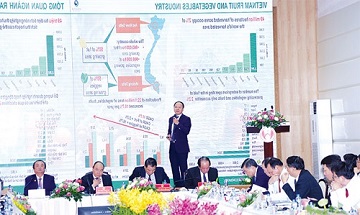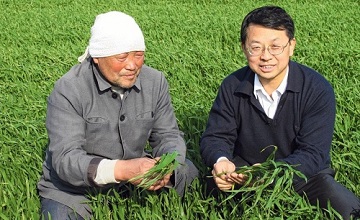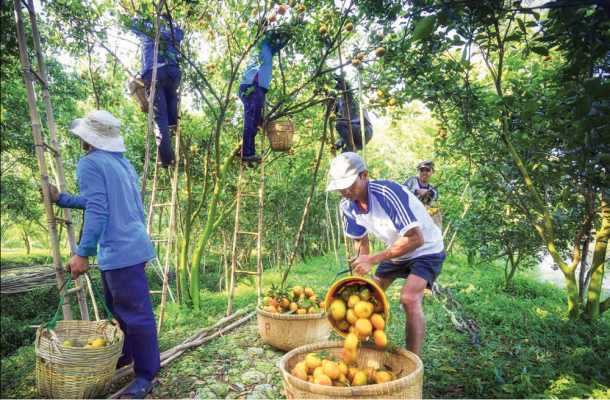Mr. Le Thanh – Director of Institute of Organic Agricultural Economics, is a familiar face in many important agricultural forum. He is considered to be the architect of the fruit and vegetable value chain oriented international market in the Tay Ninh model. Our conversation started with the word “organic”.

Mr. Le Thanh – Director of Institute of Organic Agricultural Economics
Mr. Le Thanh said:
Looking back on history, Vietnamese agriculture focused on the technical factors of cultivation and husbandry. The agricultural economy has not been thoroughly researched. One of the visual implications is the rescues of agricultural products always happening in the specific period of time. There are many reasons mainly derived from policy making. The founders of the institute agreed to participate in agricultural policy, agricultural economic modeling, investment linkage, technology transfer and training. The word “organic” has two implications. Firstly, it means the trend of agriculture’s world. Secondly, it means the reciprocal relationship, (win-win).
It is known that the Institute in cooperation with Tay Ninh’s leaders to develop agricultural value chain in order to integrate into the international market and the local pilot model. How does this model differ from traditional thinking?
This model is approached from market demand. World’s favourite consumption trend is the vegetable and fruit. Market scale processing of this sector in 2016 reached 317 billion US dollars, the growth rate is about 20%. In 2017, the export of vegetables and fruits brought to Vietnam $ 3.45 billion, up 40.5% over the previous year. This feat did not surprise us.
Yet, it is difficult to convince without taking action. Therefore, together with Lavifood, we decided to invest VND 1,500 billion to build a vegetable processing factory in Tay Ninh province under the LEED Silver standard. This multi-purpose plant is more than a kilometer long, with eight assemble lines applied European technology. In parallel with the construction process, we persevere discussions with the Government, Ministry of Agriculture and Rural Development and local authorities. After one year of implementation, vegetable and fruit have been identified by the Government as a key sector at the agricultural forum in Dong Thap in December 2017. The thinking of policymakers has changed in the direction of the world market, and put the concept of agricultural development along the value chain in resolutions. The change from upstream contributes to social mobilization.
In recent months, there have been signs that the move of large enterprise-class investment in the processing industry. What to say, industry development definitely must have the leading enterprises.
Can you please make it clearer?
The world market is very tough. Big men in the global retail industry demand very high-quality standards. The secret lies in technology. The global playground has no place for investors short of funds. Significant investments in technology are offset by marketing cost reduction. Why?
All big men in the retail industry have already established relationships with technology vendors. Technology buyers become potential suppliers. At the forum in Dong Thap, the No.2 US Fruit Retailer signed an order worth $ 100 million.

 Mr. Le Thanh gave an overview of vegetable and fruit industry and logistics at the forum in December 2017 in Dong Thap
Mr. Le Thanh gave an overview of vegetable and fruit industry and logistics at the forum in December 2017 in Dong Thap
When designing the pilot model in Tay Ninh, we chose Lavifood, which owns a big factory in Long An to reach the global standard. The available resources are fundamental for Lavifood to take on the task of leading the value chain in Tay Ninh.
Continuing with the story of the international marketing of agricultural products. I think we are in dire need of global marketers. The evidence is that Vietnamese agricultural products are absent from reputable international agricultural fairs. If so, booth location is also very humble, faint impression. This is one of the reasons that some Vietnamese commodities (coffee, rice, pepper …) are on the top 3 of export volume but we can not set the price. Many countries that are export-oriented have adopted a national market development model, which works very effectively.
Should this model be public sector or private sector?
According to the world experience, the state should let the private market do. For example, Thailand’s sugar industry, 5 enterprises shoulder the task of country negotiation, and reallocation of quotas for the industry. In our country, the state should allow the association to implement. However, this model is still more politically and socially. Multi-tasking makes it difficult for the association to work effectively.
Associations in the form of extended arms of the state do not work effectively. Is there any solution out of this dilemma, sir?
This is the advantage of the value chain that is receiving support from the State. Pilot model in Tay Ninh has 18 participating enterprises that Lavifood takes the lead role. So while sitting at the negotiating table with foreigners, Mr. Pham Ngo Quoc Thang (Chairman of the Board, General Director of Lavifood) carries the whole chain. Stronger bargaining power helped him win lemon seedlings purchased from Taiwan at $ 1 per tree, half cheaper than the retail price. The difference is that the first beneficiaries are farmers. And yet, Lavifood’s agricultural materials paying in advance at the wholesale price also helps farmers saving loan interest for production. Reasonable price reduction improves international competitiveness. Finally, the global value chain of tens of thousands of hectares has created a spillover effect with many supporting industries, expanding the fertilizer market; systems, irrigation equipment…
Rural commercial currently controlled by traders. May chain formation conflict with the interests of the rowdy force?
It is undeniable that the role of traders presents in many stages from growing areas to the table. They operate under the law, purchasing and sale agreement. However, when coming to a mango garden, traders usually buy only fruits graded type 1, type 2. The rest is self-consumption of farmers. Chain formations give farmers an alternative choice. Type 1 is exported by factories. Type 2 is sold freshly in domestic market. Type 3 is put into the condensed line. Type 4 is dried. Type 5 is used to make bottled water. Looking at their money over the time, farmers will find it more profitable to cooperate with the plant. In terms of distance, the plant is also close to the planted area, which is easy to transport.
The fact is that Dong Thap farmers transported their products to Lavifood’s factory in Long An. Then, we will rearrange the game for traders. If they join the chain, they will become the company’s commercial representative. That is the trasnparent game.
I expect the value chain will be a key solution to the rural commercial market.
Is there any other challenge, sir?
Yes. Vietnam’s logistics costs currently account for about 25% of GDP, while many countries only about 8% to 10%. Infrastructure challenge is not an easy story. According to statistics, the average rate of food rate in the world is about 40%, Vietnam can be 50-60%, in which the loss on the transport accounts for the largest proportion. The solution to the problem of infrastructure couldn’t solve quickly. But that’s still not the biggest challenge. Unlike industry, it is easy to attract labour to concentrate, to organize training and production, to work in agriculture, to be attached to farmers. Their land is there, passing through many generations. For a very long time, farmers cultivated by experience. Low discipline is the greatest challenge. Value chain’s farmers are supported, in return they have to commit to compliance with a standard system. Based on that, the plant organizes training, brings farming technicians to the field with farmers, even plugging the sensor into the field, recording information required by international partners. Not many farmers have followed up with this method.
We work with provincial leaders, produce guidance programs and put them on local media and governments and appoint more extension officers to support. This is a stepping stone for people to organize the growing area, the habit of management. Next, the Institute worked with the Vietnam Cooperative Alliance, established a new type of international cooperative model. We support the successful cooperative members to become the nucleus of the community. Relatives, neighbours help her them understand each other easily.
Dozens of years of industrialization has created a wave of urban migration, leaving a room for rural workers. Is human resource a factor to be considered? In 1996, we began to develop industrial parks. If young people whom 20 years of age when began to work continuously at a factory, then to this point, they also about reach to the working age. Without employment after leaving the factory, this force would become a burden to society. To me, discipline and industrial working style they’ve been practicing for more than two decades with are resources for the development of agricultural value chains.
I contacted the director of a foreign-invested enterprise in Trang Bang Industrial Park. The factory is about to close down its investment cycle, and he is worried about the future of thousands of workers who have been with him for the past two decades. After discussing with the leaders of Tay Ninh province, I suggested that they should start a new investment cycle in the agricultural sector in order to shift the labour force. After the report of the Group, he responded that “very positive signal”. I think there are many investors having “human love”. Yet, the problem is that we should have solutions to unfreeze and to leverage “social capital” as a valuable resource into economic development.
Thank you for this interview!
Source: Nha Quan Ly Magazine (2018)

 Tiếng Việt
Tiếng Việt




